When electric lines first appeared in front of the Paris Opera House, people weren’t too keen on it. But, “Once Paris decided it was going to be modern … people got used to it,” said Emanuel J. Carter Jr., an associate professor at the State University of New York’s College of Environmental Science and Forestry specializing in city planning.
As America is incorporating more and more solar energy into its grids, more and more solar arrays are meeting with community opposition.
One of the common reasons for opposition is aesthetics. With aesthetic worries often also comes the fear of decreasing property values near solar arrays.
“It’s simply a design problem,” Carter said. “Figure out how to make it beautiful and useful.”
Some residential panels are poorly installed without consideration of aesthetics. Some larger-scale community arrays could also be better designed.
To see examples of panels that may be considered ugly, click here, here, and here



“Part of it is a question of taking advantage of the right roof lines and going in the right direction,” Carter said. “But part of it is also having a community get used to the idea.”
Cities and towns have had to incorporate new elements for centuries, even millennia. In the past couple of centuries, many modern elements of city infrastructure have appeared, including telephone and electrical lines.
Like transportation, roadways, and any other element of city planning, solar arrays should be carefully considered, Carter said.
“Any good urban designer, any good landscape architect can design the area around a solar array so that it actually becomes beautiful, perhaps even sculptural,” he said. “Perhaps the streets around it are heavily tree-lined so that any sense of glare or any sense of a monotonous flat field of something becomes hidden.
“It doesn’t have to be something that is ugly right across the street from a lot of houses that devalue the houses.”


Carter himself has solar panels on his home in Syracuse, New York, which plug into the grid and provide 80 percent of his electricity. Some of his neighbors do the same.
Many Americans have put up solar panels only to be forced by homeowner associations to take them down again. Solar Town, a clean energy systems provider, suggests people check the Covenants, Conditions & Restrictions issued by their homeowner association.
Common obstacles presented by the CC&R include:
Restrictions related to architectural style, which may open the door to objects concerning how harmonious the panel design is with the rest of the building.
Restrictions on the placement of improvements, which may dictate that the panels can’t be visible from the street.
Restrictions on the placement of structures within a certain distance of property lines.
New England Clean Energy’s founder and president Mark Durrenberger gives further insights on his blog as to what makes a residential installation good, bad, or ugly.
For example it’s good to hide conduit runs under the panels and inside attics, instead of running them over the top of the roof.
He wrote: “If you’re going to put something on your home for a few decades, it should add to your home’s appeal, not detract from it.”
Follow @EpochEnviro on Twitter.





